Organizational Communication, Culture, and Improvement: Report
VerifiedAdded on 2023/06/10
|11
|2024
|132
Report
AI Summary
This report provides an analysis of organizational communication, differentiating between formal (upward, downward, horizontal, diagonal) and informal (grapevine) modes, with examples. It delves into organizational culture, examining its components like stories, rituals, heroes, and symbols, applying these to Fonterra. The impact of New Zealand's culture on Fonterra's work ethic and ethical business decisions is discussed. Recommendations are made on how organizations can demonstrate culture in daily activities. The report also identifies key strengths in professional, presentational, written, and group work, along with areas for improvement and an action plan for undertaking these improvements, emphasizing the importance of training, communication skills, and management abilities. Desklib provides similar past papers and solved assignments for students.
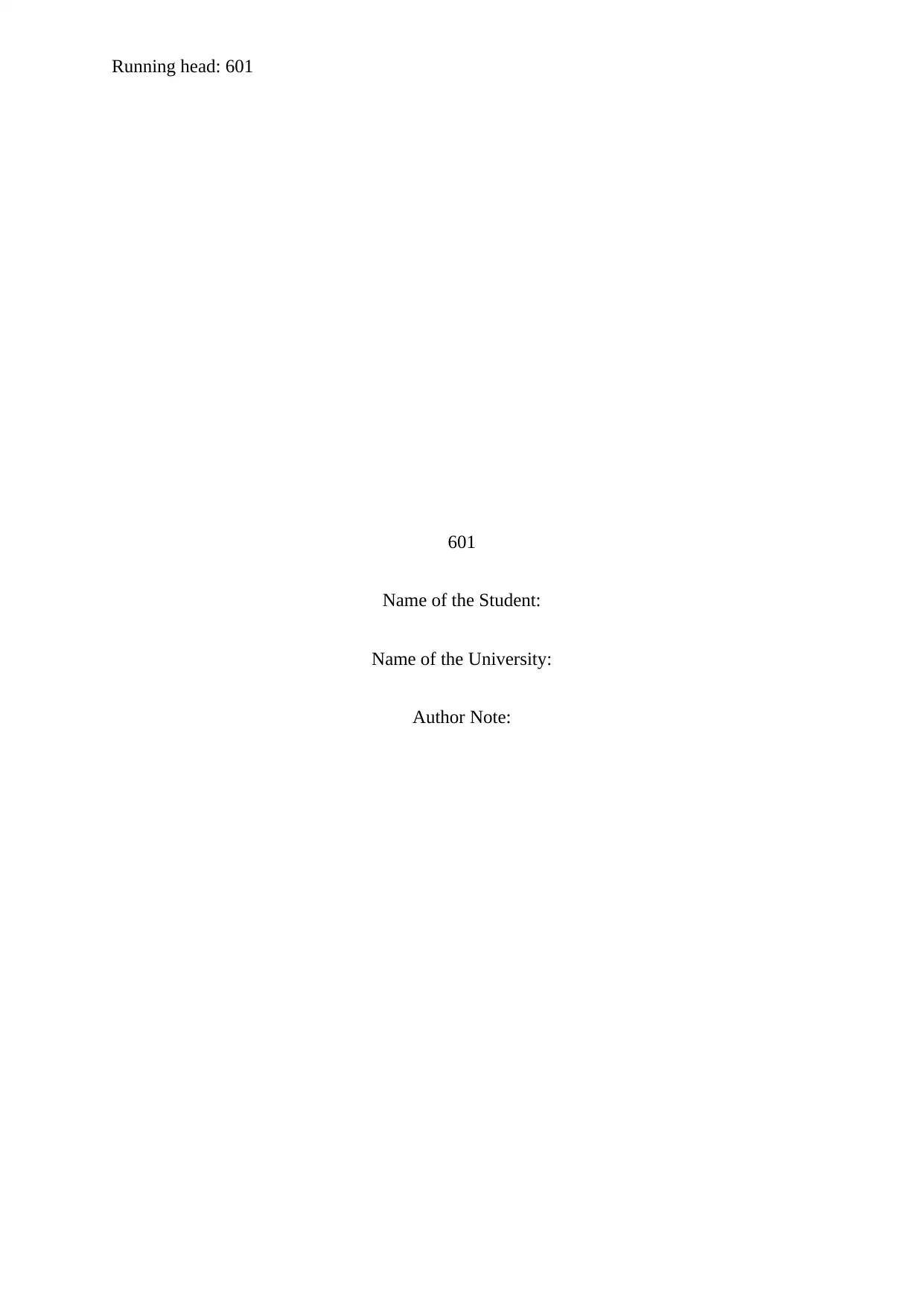
Running head: 601
601
Name of the Student:
Name of the University:
Author Note:
601
Name of the Student:
Name of the University:
Author Note:
Paraphrase This Document
Need a fresh take? Get an instant paraphrase of this document with our AI Paraphraser
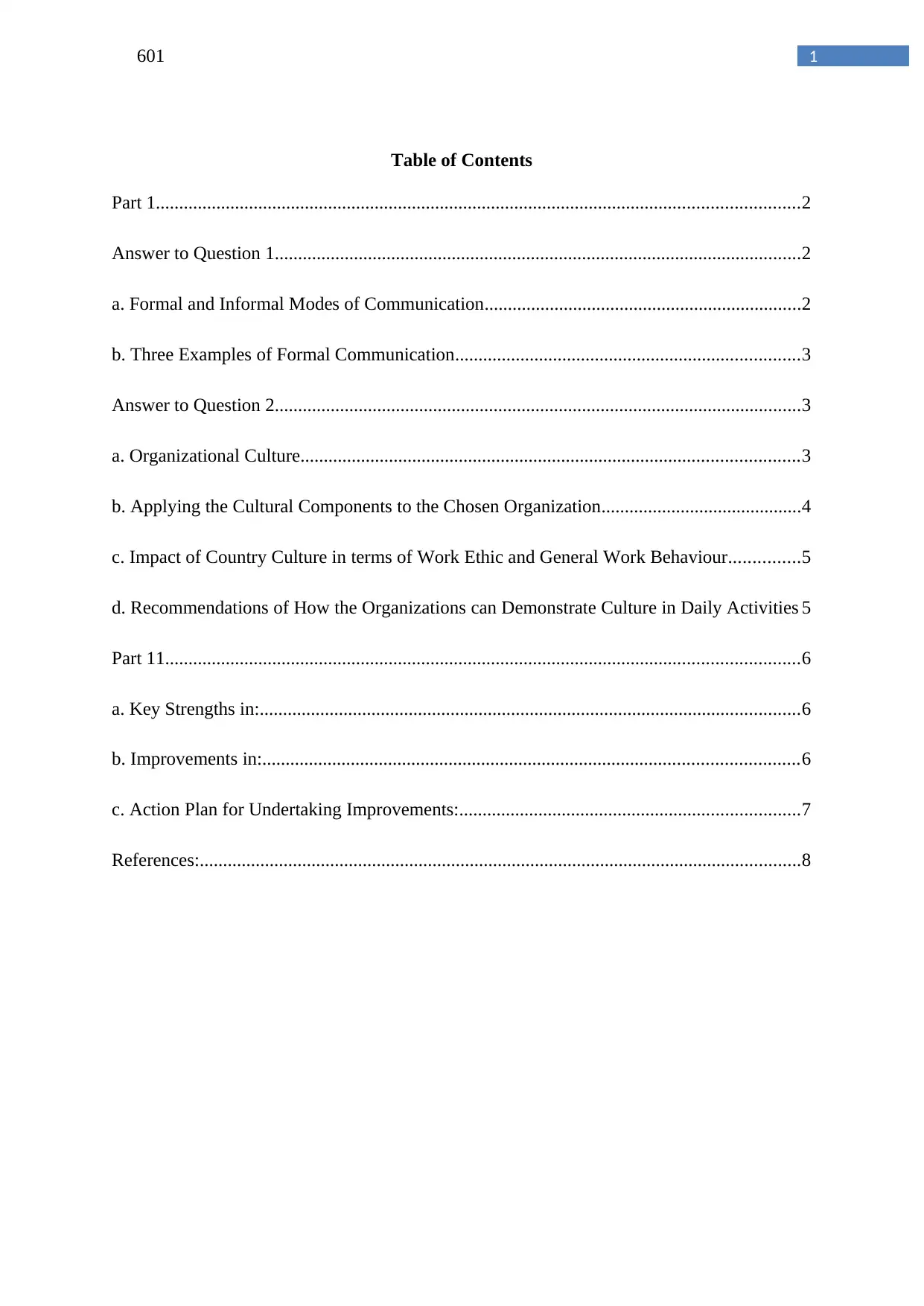
1601
Table of Contents
Part 1..........................................................................................................................................2
Answer to Question 1.................................................................................................................2
a. Formal and Informal Modes of Communication....................................................................2
b. Three Examples of Formal Communication..........................................................................3
Answer to Question 2.................................................................................................................3
a. Organizational Culture...........................................................................................................3
b. Applying the Cultural Components to the Chosen Organization...........................................4
c. Impact of Country Culture in terms of Work Ethic and General Work Behaviour...............5
d. Recommendations of How the Organizations can Demonstrate Culture in Daily Activities 5
Part 11........................................................................................................................................6
a. Key Strengths in:....................................................................................................................6
b. Improvements in:...................................................................................................................6
c. Action Plan for Undertaking Improvements:.........................................................................7
References:.................................................................................................................................8
Table of Contents
Part 1..........................................................................................................................................2
Answer to Question 1.................................................................................................................2
a. Formal and Informal Modes of Communication....................................................................2
b. Three Examples of Formal Communication..........................................................................3
Answer to Question 2.................................................................................................................3
a. Organizational Culture...........................................................................................................3
b. Applying the Cultural Components to the Chosen Organization...........................................4
c. Impact of Country Culture in terms of Work Ethic and General Work Behaviour...............5
d. Recommendations of How the Organizations can Demonstrate Culture in Daily Activities 5
Part 11........................................................................................................................................6
a. Key Strengths in:....................................................................................................................6
b. Improvements in:...................................................................................................................6
c. Action Plan for Undertaking Improvements:.........................................................................7
References:.................................................................................................................................8
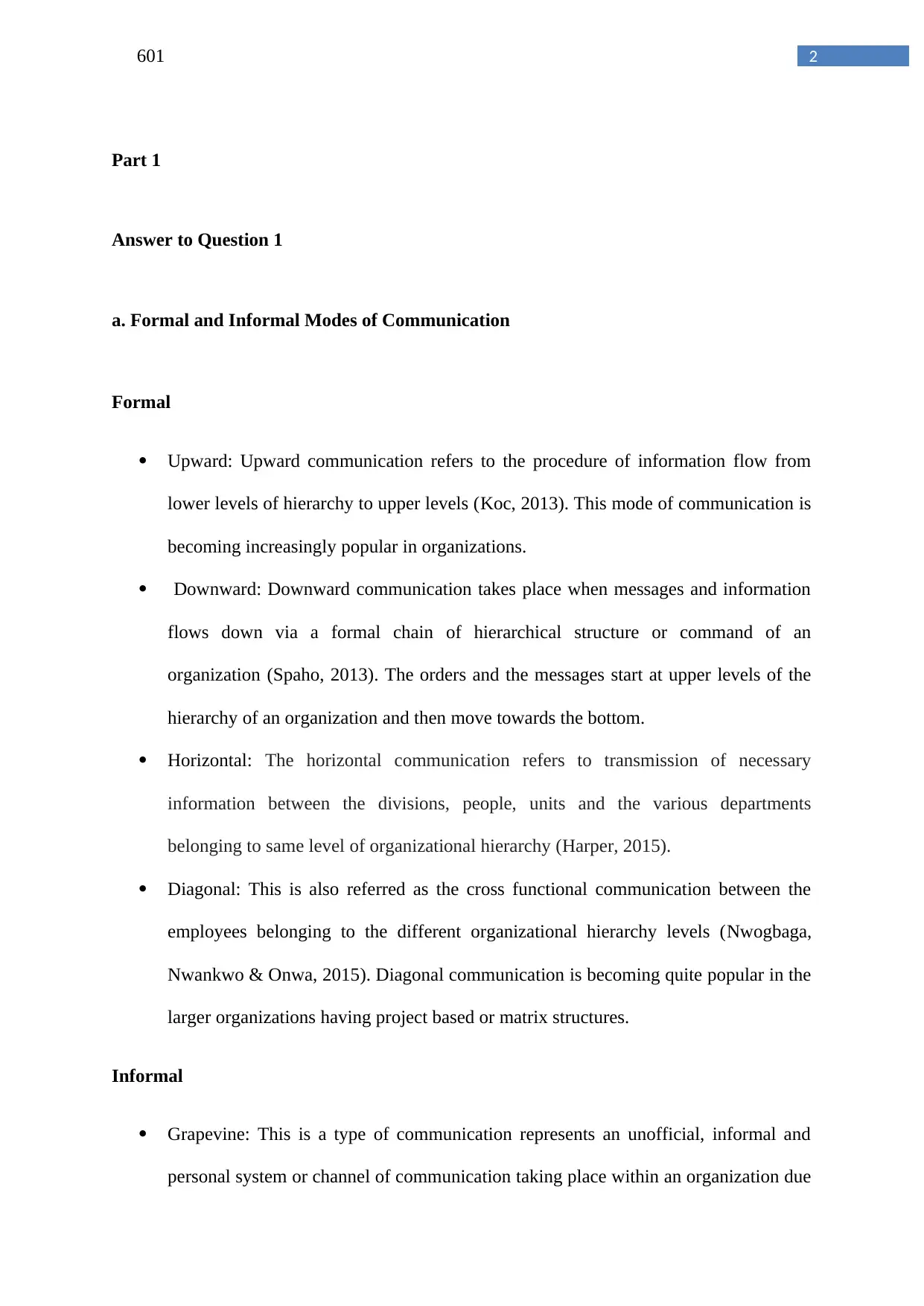
2601
Part 1
Answer to Question 1
a. Formal and Informal Modes of Communication
Formal
Upward: Upward communication refers to the procedure of information flow from
lower levels of hierarchy to upper levels (Koc, 2013). This mode of communication is
becoming increasingly popular in organizations.
Downward: Downward communication takes place when messages and information
flows down via a formal chain of hierarchical structure or command of an
organization (Spaho, 2013). The orders and the messages start at upper levels of the
hierarchy of an organization and then move towards the bottom.
Horizontal: The horizontal communication refers to transmission of necessary
information between the divisions, people, units and the various departments
belonging to same level of organizational hierarchy (Harper, 2015).
Diagonal: This is also referred as the cross functional communication between the
employees belonging to the different organizational hierarchy levels (Nwogbaga,
Nwankwo & Onwa, 2015). Diagonal communication is becoming quite popular in the
larger organizations having project based or matrix structures.
Informal
Grapevine: This is a type of communication represents an unofficial, informal and
personal system or channel of communication taking place within an organization due
Part 1
Answer to Question 1
a. Formal and Informal Modes of Communication
Formal
Upward: Upward communication refers to the procedure of information flow from
lower levels of hierarchy to upper levels (Koc, 2013). This mode of communication is
becoming increasingly popular in organizations.
Downward: Downward communication takes place when messages and information
flows down via a formal chain of hierarchical structure or command of an
organization (Spaho, 2013). The orders and the messages start at upper levels of the
hierarchy of an organization and then move towards the bottom.
Horizontal: The horizontal communication refers to transmission of necessary
information between the divisions, people, units and the various departments
belonging to same level of organizational hierarchy (Harper, 2015).
Diagonal: This is also referred as the cross functional communication between the
employees belonging to the different organizational hierarchy levels (Nwogbaga,
Nwankwo & Onwa, 2015). Diagonal communication is becoming quite popular in the
larger organizations having project based or matrix structures.
Informal
Grapevine: This is a type of communication represents an unofficial, informal and
personal system or channel of communication taking place within an organization due
⊘ This is a preview!⊘
Do you want full access?
Subscribe today to unlock all pages.

Trusted by 1+ million students worldwide
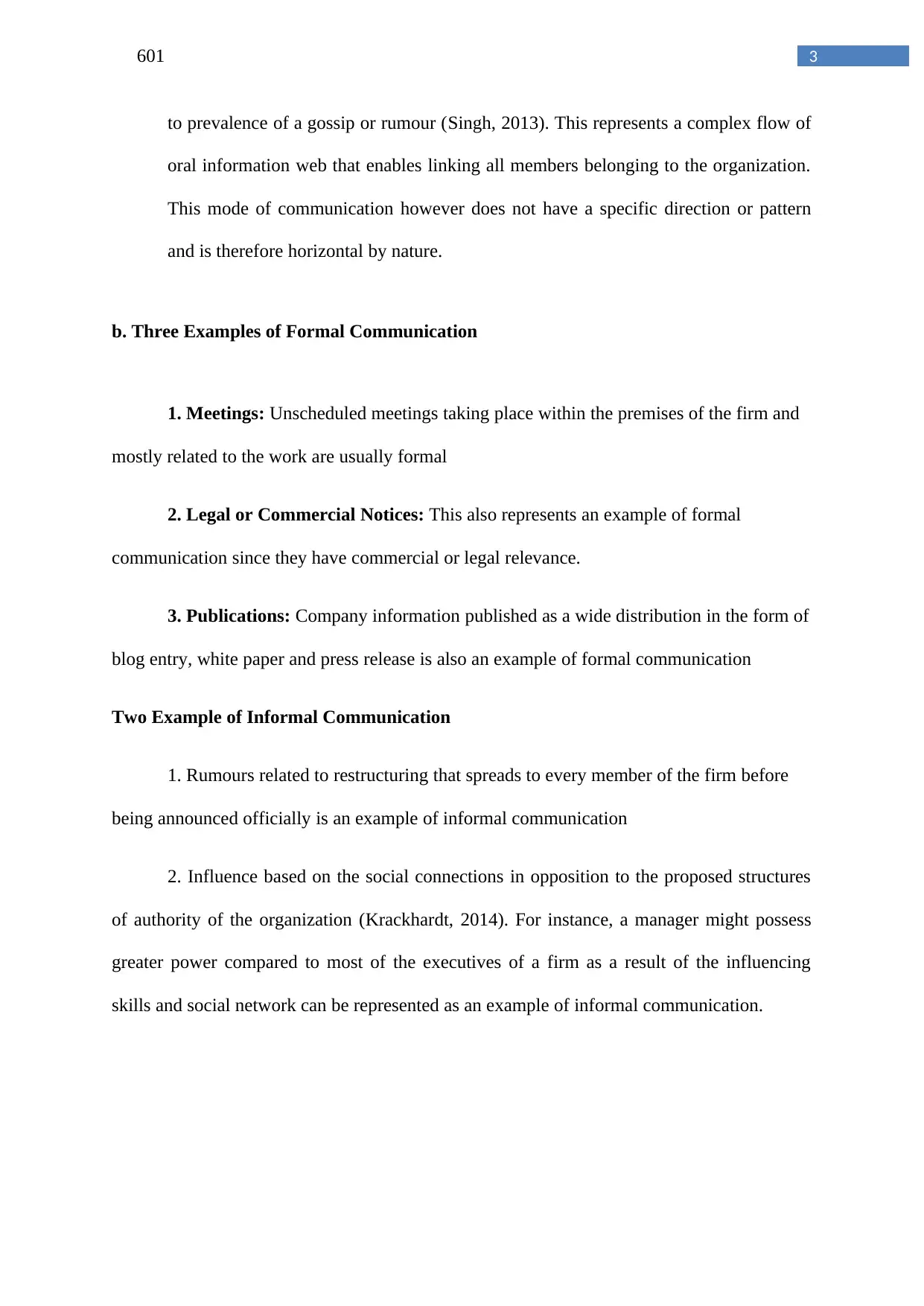
3601
to prevalence of a gossip or rumour (Singh, 2013). This represents a complex flow of
oral information web that enables linking all members belonging to the organization.
This mode of communication however does not have a specific direction or pattern
and is therefore horizontal by nature.
b. Three Examples of Formal Communication
1. Meetings: Unscheduled meetings taking place within the premises of the firm and
mostly related to the work are usually formal
2. Legal or Commercial Notices: This also represents an example of formal
communication since they have commercial or legal relevance.
3. Publications: Company information published as a wide distribution in the form of
blog entry, white paper and press release is also an example of formal communication
Two Example of Informal Communication
1. Rumours related to restructuring that spreads to every member of the firm before
being announced officially is an example of informal communication
2. Influence based on the social connections in opposition to the proposed structures
of authority of the organization (Krackhardt, 2014). For instance, a manager might possess
greater power compared to most of the executives of a firm as a result of the influencing
skills and social network can be represented as an example of informal communication.
to prevalence of a gossip or rumour (Singh, 2013). This represents a complex flow of
oral information web that enables linking all members belonging to the organization.
This mode of communication however does not have a specific direction or pattern
and is therefore horizontal by nature.
b. Three Examples of Formal Communication
1. Meetings: Unscheduled meetings taking place within the premises of the firm and
mostly related to the work are usually formal
2. Legal or Commercial Notices: This also represents an example of formal
communication since they have commercial or legal relevance.
3. Publications: Company information published as a wide distribution in the form of
blog entry, white paper and press release is also an example of formal communication
Two Example of Informal Communication
1. Rumours related to restructuring that spreads to every member of the firm before
being announced officially is an example of informal communication
2. Influence based on the social connections in opposition to the proposed structures
of authority of the organization (Krackhardt, 2014). For instance, a manager might possess
greater power compared to most of the executives of a firm as a result of the influencing
skills and social network can be represented as an example of informal communication.
Paraphrase This Document
Need a fresh take? Get an instant paraphrase of this document with our AI Paraphraser
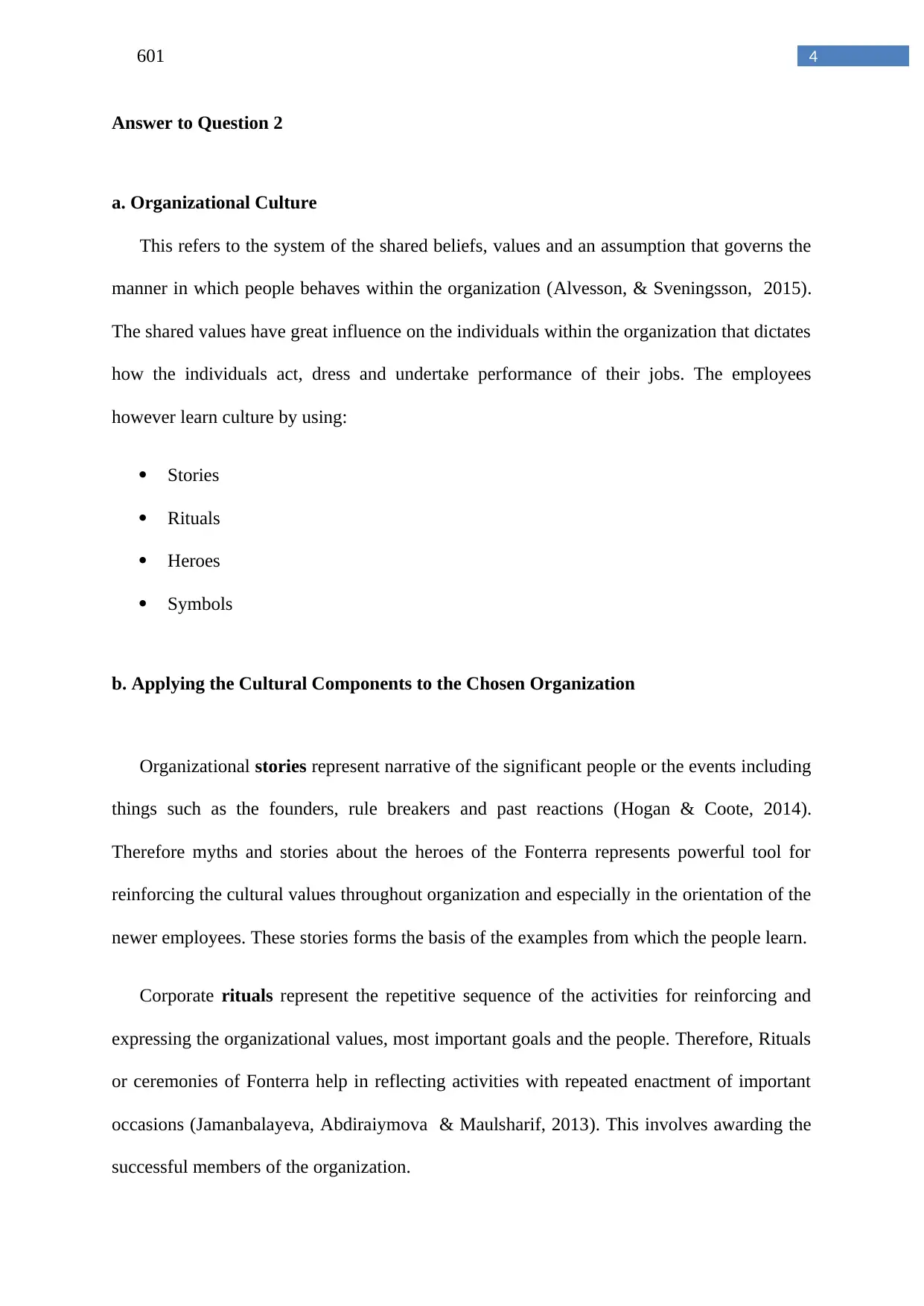
4601
Answer to Question 2
a. Organizational Culture
This refers to the system of the shared beliefs, values and an assumption that governs the
manner in which people behaves within the organization (Alvesson, & Sveningsson, 2015).
The shared values have great influence on the individuals within the organization that dictates
how the individuals act, dress and undertake performance of their jobs. The employees
however learn culture by using:
Stories
Rituals
Heroes
Symbols
b. Applying the Cultural Components to the Chosen Organization
Organizational stories represent narrative of the significant people or the events including
things such as the founders, rule breakers and past reactions (Hogan & Coote, 2014).
Therefore myths and stories about the heroes of the Fonterra represents powerful tool for
reinforcing the cultural values throughout organization and especially in the orientation of the
newer employees. These stories forms the basis of the examples from which the people learn.
Corporate rituals represent the repetitive sequence of the activities for reinforcing and
expressing the organizational values, most important goals and the people. Therefore, Rituals
or ceremonies of Fonterra help in reflecting activities with repeated enactment of important
occasions (Jamanbalayeva, Abdiraiymova & Maulsharif, 2013). This involves awarding the
successful members of the organization.
Answer to Question 2
a. Organizational Culture
This refers to the system of the shared beliefs, values and an assumption that governs the
manner in which people behaves within the organization (Alvesson, & Sveningsson, 2015).
The shared values have great influence on the individuals within the organization that dictates
how the individuals act, dress and undertake performance of their jobs. The employees
however learn culture by using:
Stories
Rituals
Heroes
Symbols
b. Applying the Cultural Components to the Chosen Organization
Organizational stories represent narrative of the significant people or the events including
things such as the founders, rule breakers and past reactions (Hogan & Coote, 2014).
Therefore myths and stories about the heroes of the Fonterra represents powerful tool for
reinforcing the cultural values throughout organization and especially in the orientation of the
newer employees. These stories forms the basis of the examples from which the people learn.
Corporate rituals represent the repetitive sequence of the activities for reinforcing and
expressing the organizational values, most important goals and the people. Therefore, Rituals
or ceremonies of Fonterra help in reflecting activities with repeated enactment of important
occasions (Jamanbalayeva, Abdiraiymova & Maulsharif, 2013). This involves awarding the
successful members of the organization.
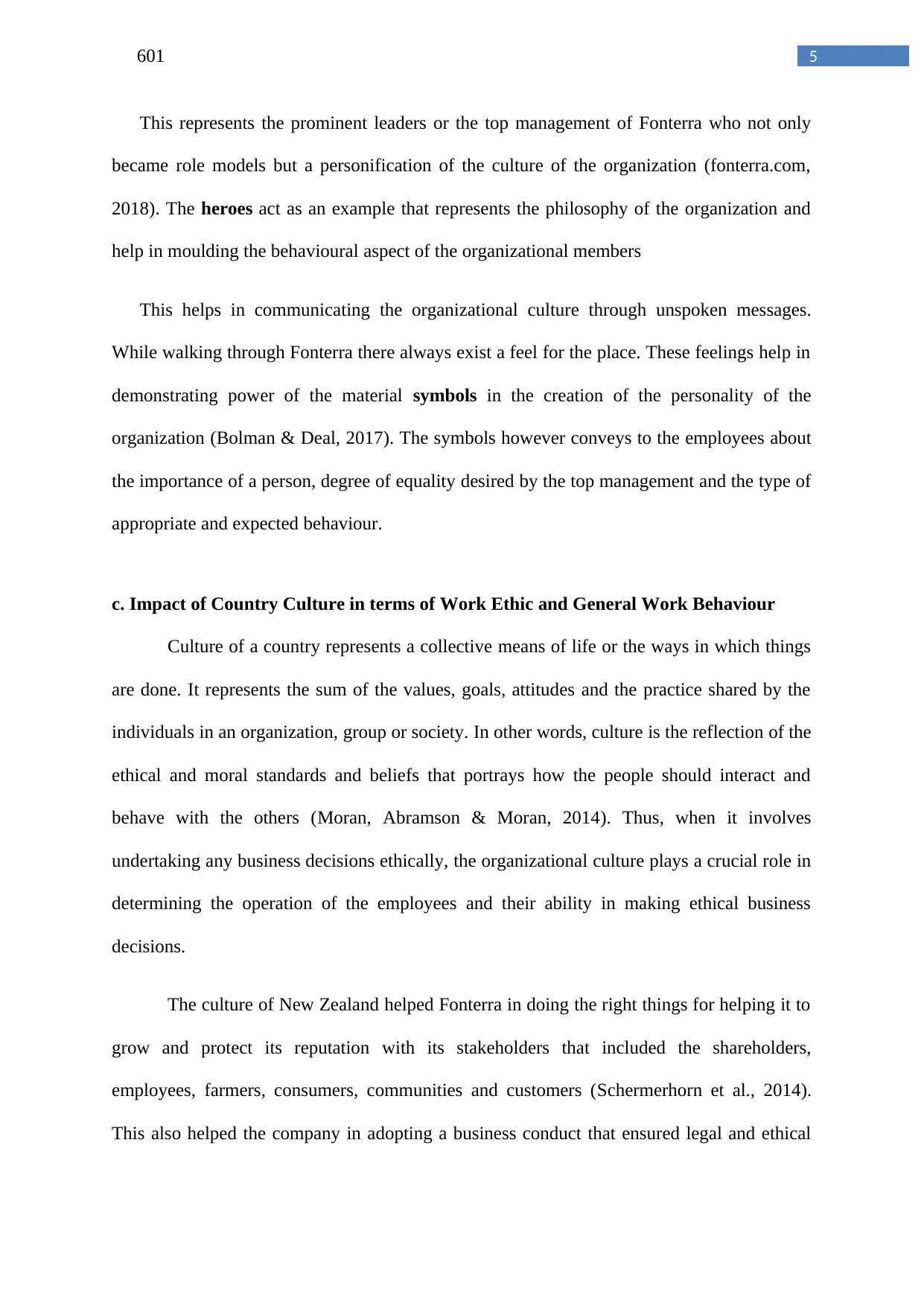
5601
This represents the prominent leaders or the top management of Fonterra who not only
became role models but a personification of the culture of the organization (fonterra.com,
2018). The heroes act as an example that represents the philosophy of the organization and
help in moulding the behavioural aspect of the organizational members
This helps in communicating the organizational culture through unspoken messages.
While walking through Fonterra there always exist a feel for the place. These feelings help in
demonstrating power of the material symbols in the creation of the personality of the
organization (Bolman & Deal, 2017). The symbols however conveys to the employees about
the importance of a person, degree of equality desired by the top management and the type of
appropriate and expected behaviour.
c. Impact of Country Culture in terms of Work Ethic and General Work Behaviour
Culture of a country represents a collective means of life or the ways in which things
are done. It represents the sum of the values, goals, attitudes and the practice shared by the
individuals in an organization, group or society. In other words, culture is the reflection of the
ethical and moral standards and beliefs that portrays how the people should interact and
behave with the others (Moran, Abramson & Moran, 2014). Thus, when it involves
undertaking any business decisions ethically, the organizational culture plays a crucial role in
determining the operation of the employees and their ability in making ethical business
decisions.
The culture of New Zealand helped Fonterra in doing the right things for helping it to
grow and protect its reputation with its stakeholders that included the shareholders,
employees, farmers, consumers, communities and customers (Schermerhorn et al., 2014).
This also helped the company in adopting a business conduct that ensured legal and ethical
This represents the prominent leaders or the top management of Fonterra who not only
became role models but a personification of the culture of the organization (fonterra.com,
2018). The heroes act as an example that represents the philosophy of the organization and
help in moulding the behavioural aspect of the organizational members
This helps in communicating the organizational culture through unspoken messages.
While walking through Fonterra there always exist a feel for the place. These feelings help in
demonstrating power of the material symbols in the creation of the personality of the
organization (Bolman & Deal, 2017). The symbols however conveys to the employees about
the importance of a person, degree of equality desired by the top management and the type of
appropriate and expected behaviour.
c. Impact of Country Culture in terms of Work Ethic and General Work Behaviour
Culture of a country represents a collective means of life or the ways in which things
are done. It represents the sum of the values, goals, attitudes and the practice shared by the
individuals in an organization, group or society. In other words, culture is the reflection of the
ethical and moral standards and beliefs that portrays how the people should interact and
behave with the others (Moran, Abramson & Moran, 2014). Thus, when it involves
undertaking any business decisions ethically, the organizational culture plays a crucial role in
determining the operation of the employees and their ability in making ethical business
decisions.
The culture of New Zealand helped Fonterra in doing the right things for helping it to
grow and protect its reputation with its stakeholders that included the shareholders,
employees, farmers, consumers, communities and customers (Schermerhorn et al., 2014).
This also helped the company in adopting a business conduct that ensured legal and ethical
⊘ This is a preview!⊘
Do you want full access?
Subscribe today to unlock all pages.

Trusted by 1+ million students worldwide
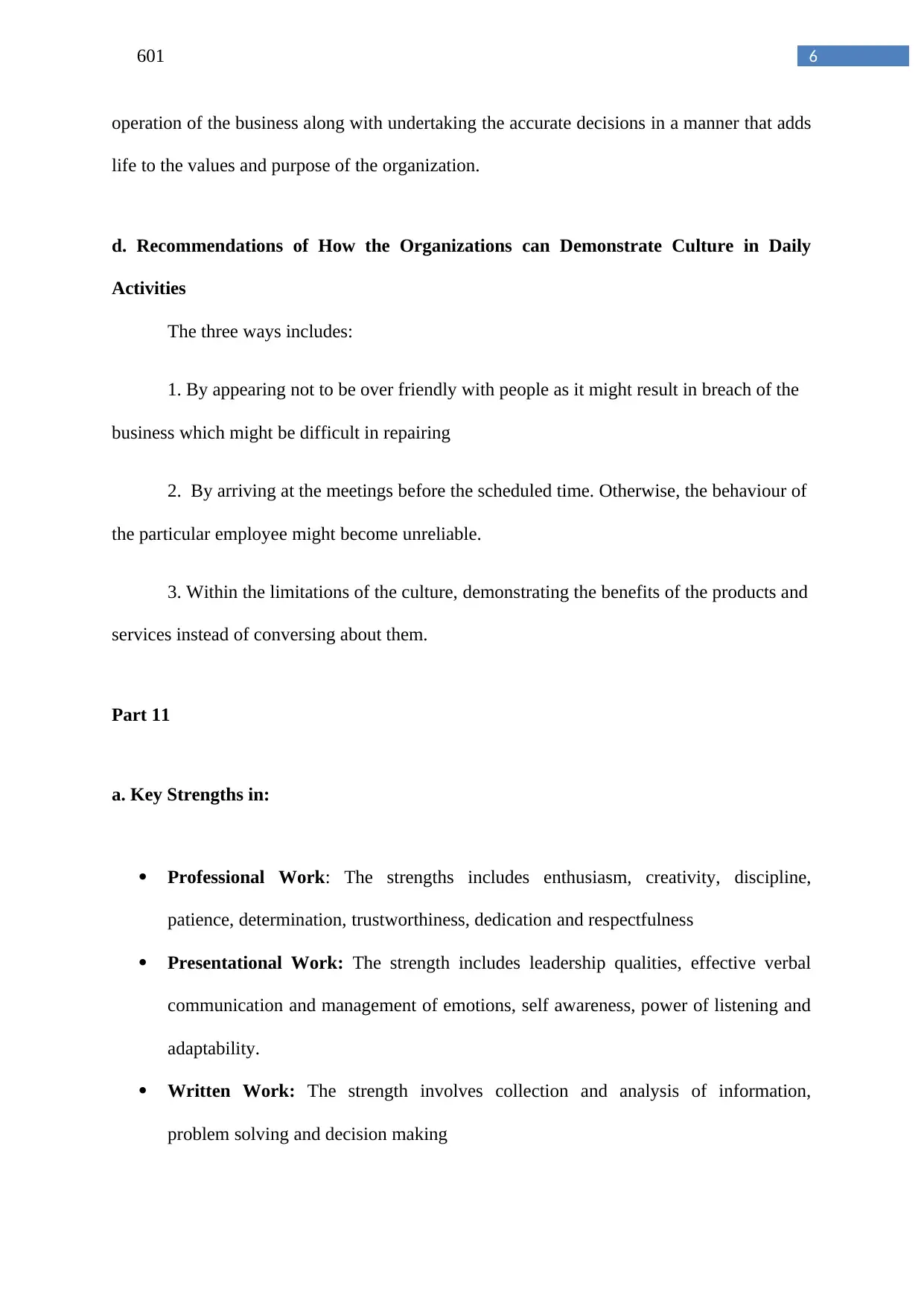
6601
operation of the business along with undertaking the accurate decisions in a manner that adds
life to the values and purpose of the organization.
d. Recommendations of How the Organizations can Demonstrate Culture in Daily
Activities
The three ways includes:
1. By appearing not to be over friendly with people as it might result in breach of the
business which might be difficult in repairing
2. By arriving at the meetings before the scheduled time. Otherwise, the behaviour of
the particular employee might become unreliable.
3. Within the limitations of the culture, demonstrating the benefits of the products and
services instead of conversing about them.
Part 11
a. Key Strengths in:
Professional Work: The strengths includes enthusiasm, creativity, discipline,
patience, determination, trustworthiness, dedication and respectfulness
Presentational Work: The strength includes leadership qualities, effective verbal
communication and management of emotions, self awareness, power of listening and
adaptability.
Written Work: The strength involves collection and analysis of information,
problem solving and decision making
operation of the business along with undertaking the accurate decisions in a manner that adds
life to the values and purpose of the organization.
d. Recommendations of How the Organizations can Demonstrate Culture in Daily
Activities
The three ways includes:
1. By appearing not to be over friendly with people as it might result in breach of the
business which might be difficult in repairing
2. By arriving at the meetings before the scheduled time. Otherwise, the behaviour of
the particular employee might become unreliable.
3. Within the limitations of the culture, demonstrating the benefits of the products and
services instead of conversing about them.
Part 11
a. Key Strengths in:
Professional Work: The strengths includes enthusiasm, creativity, discipline,
patience, determination, trustworthiness, dedication and respectfulness
Presentational Work: The strength includes leadership qualities, effective verbal
communication and management of emotions, self awareness, power of listening and
adaptability.
Written Work: The strength involves collection and analysis of information,
problem solving and decision making
Paraphrase This Document
Need a fresh take? Get an instant paraphrase of this document with our AI Paraphraser
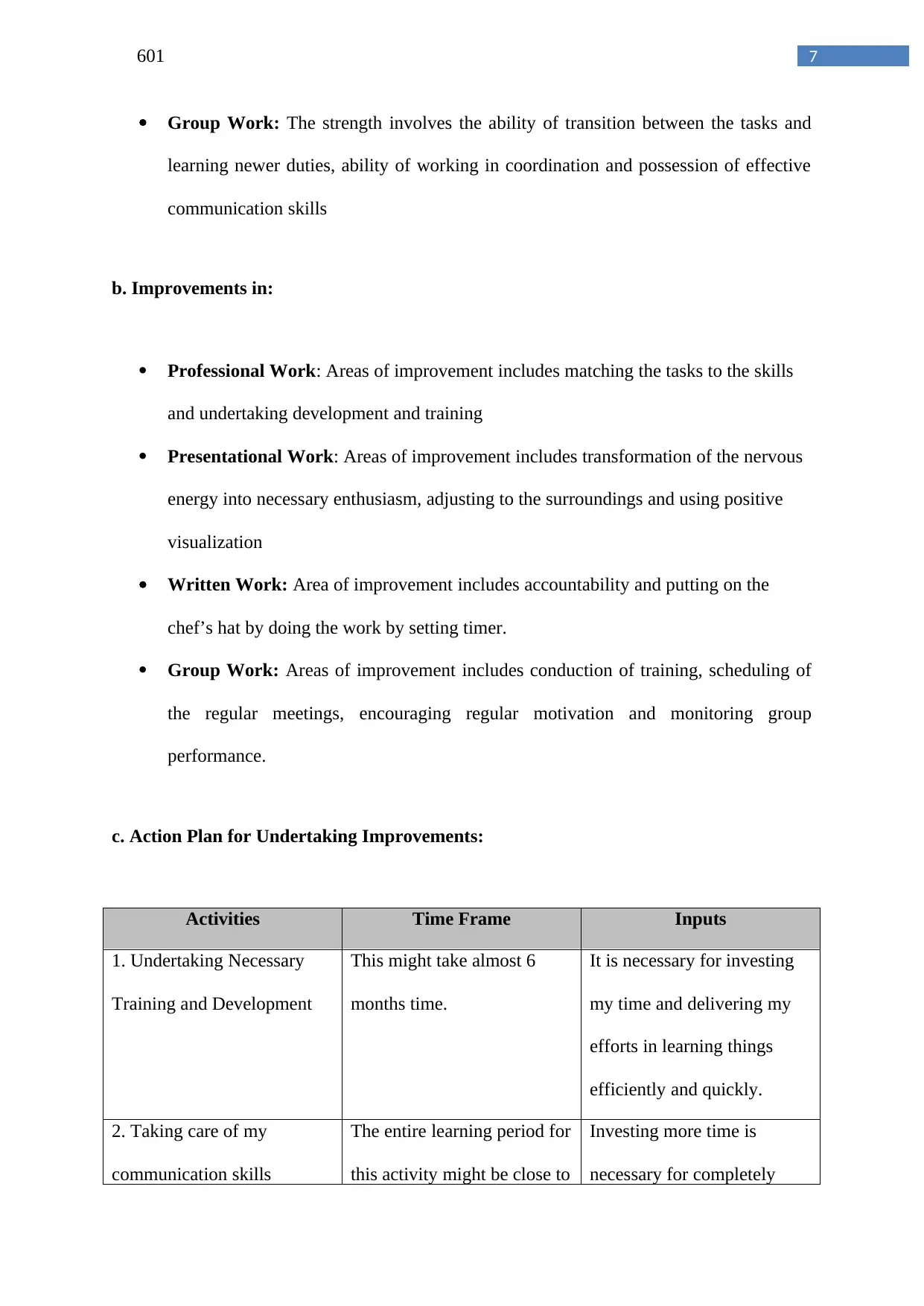
7601
Group Work: The strength involves the ability of transition between the tasks and
learning newer duties, ability of working in coordination and possession of effective
communication skills
b. Improvements in:
Professional Work: Areas of improvement includes matching the tasks to the skills
and undertaking development and training
Presentational Work: Areas of improvement includes transformation of the nervous
energy into necessary enthusiasm, adjusting to the surroundings and using positive
visualization
Written Work: Area of improvement includes accountability and putting on the
chef’s hat by doing the work by setting timer.
Group Work: Areas of improvement includes conduction of training, scheduling of
the regular meetings, encouraging regular motivation and monitoring group
performance.
c. Action Plan for Undertaking Improvements:
Activities Time Frame Inputs
1. Undertaking Necessary
Training and Development
This might take almost 6
months time.
It is necessary for investing
my time and delivering my
efforts in learning things
efficiently and quickly.
2. Taking care of my
communication skills
The entire learning period for
this activity might be close to
Investing more time is
necessary for completely
Group Work: The strength involves the ability of transition between the tasks and
learning newer duties, ability of working in coordination and possession of effective
communication skills
b. Improvements in:
Professional Work: Areas of improvement includes matching the tasks to the skills
and undertaking development and training
Presentational Work: Areas of improvement includes transformation of the nervous
energy into necessary enthusiasm, adjusting to the surroundings and using positive
visualization
Written Work: Area of improvement includes accountability and putting on the
chef’s hat by doing the work by setting timer.
Group Work: Areas of improvement includes conduction of training, scheduling of
the regular meetings, encouraging regular motivation and monitoring group
performance.
c. Action Plan for Undertaking Improvements:
Activities Time Frame Inputs
1. Undertaking Necessary
Training and Development
This might take almost 6
months time.
It is necessary for investing
my time and delivering my
efforts in learning things
efficiently and quickly.
2. Taking care of my
communication skills
The entire learning period for
this activity might be close to
Investing more time is
necessary for completely
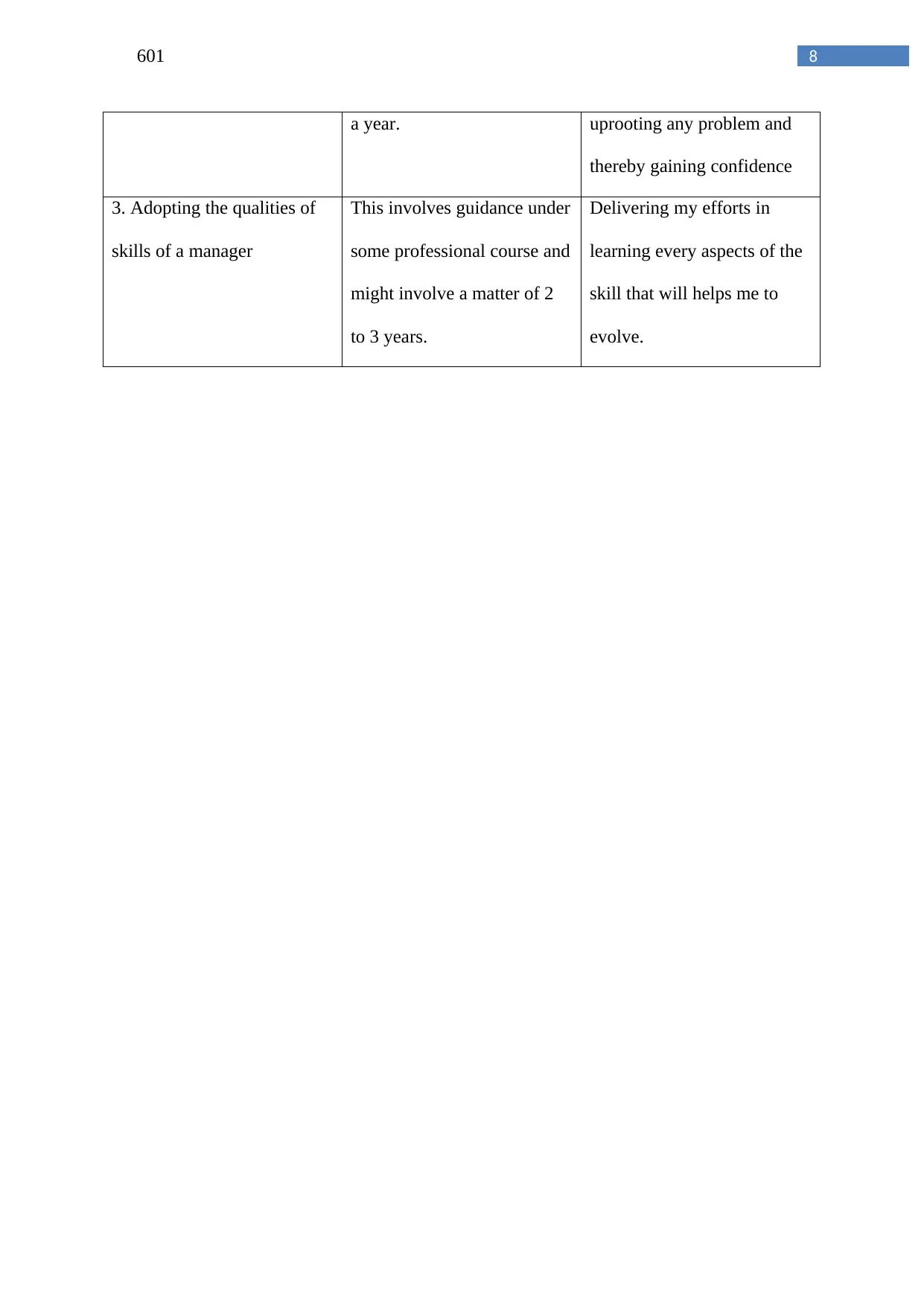
8601
a year. uprooting any problem and
thereby gaining confidence
3. Adopting the qualities of
skills of a manager
This involves guidance under
some professional course and
might involve a matter of 2
to 3 years.
Delivering my efforts in
learning every aspects of the
skill that will helps me to
evolve.
a year. uprooting any problem and
thereby gaining confidence
3. Adopting the qualities of
skills of a manager
This involves guidance under
some professional course and
might involve a matter of 2
to 3 years.
Delivering my efforts in
learning every aspects of the
skill that will helps me to
evolve.
⊘ This is a preview!⊘
Do you want full access?
Subscribe today to unlock all pages.

Trusted by 1+ million students worldwide
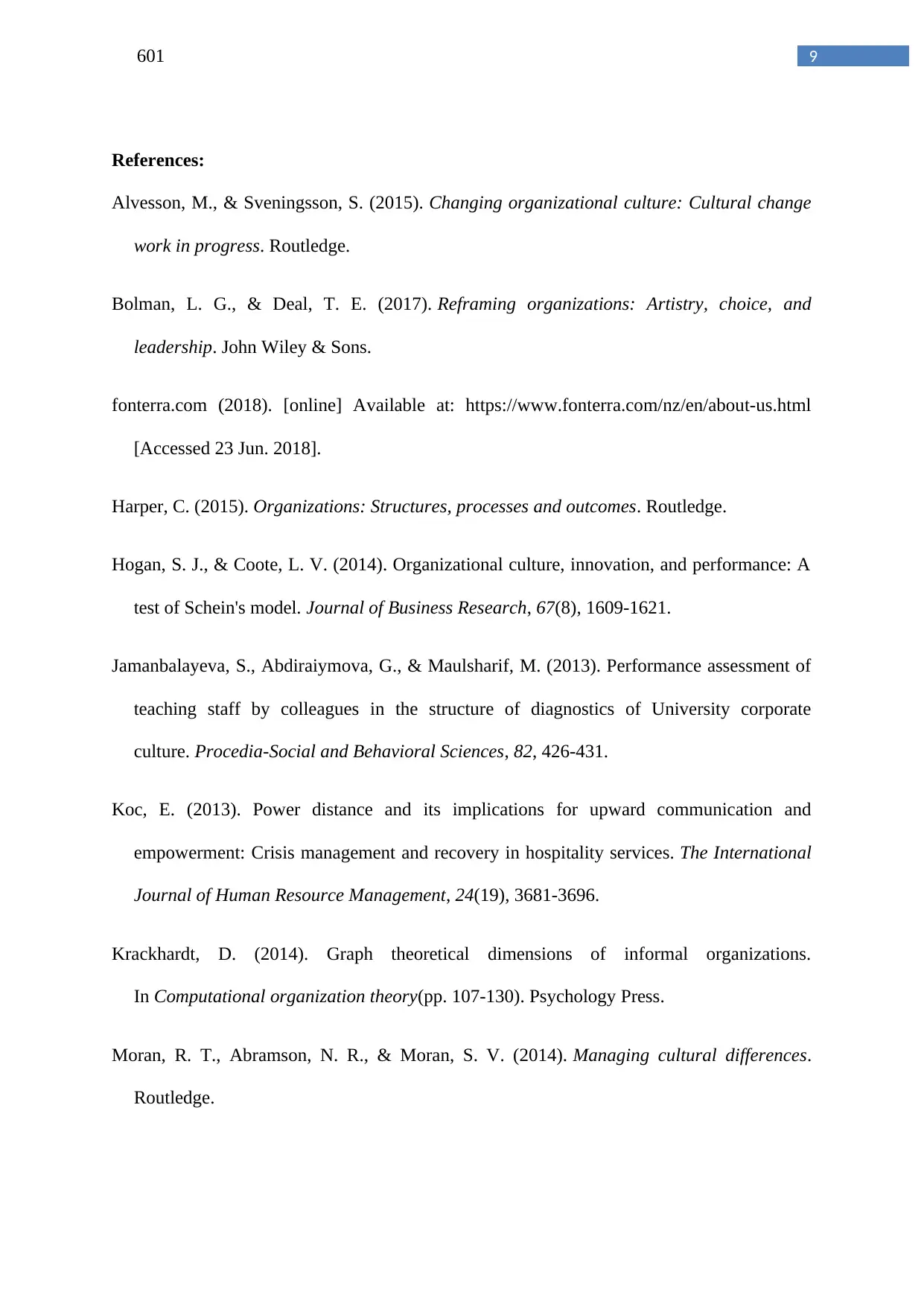
9601
References:
Alvesson, M., & Sveningsson, S. (2015). Changing organizational culture: Cultural change
work in progress. Routledge.
Bolman, L. G., & Deal, T. E. (2017). Reframing organizations: Artistry, choice, and
leadership. John Wiley & Sons.
fonterra.com (2018). [online] Available at: https://www.fonterra.com/nz/en/about-us.html
[Accessed 23 Jun. 2018].
Harper, C. (2015). Organizations: Structures, processes and outcomes. Routledge.
Hogan, S. J., & Coote, L. V. (2014). Organizational culture, innovation, and performance: A
test of Schein's model. Journal of Business Research, 67(8), 1609-1621.
Jamanbalayeva, S., Abdiraiymova, G., & Maulsharif, M. (2013). Performance assessment of
teaching staff by colleagues in the structure of diagnostics of University corporate
culture. Procedia-Social and Behavioral Sciences, 82, 426-431.
Koc, E. (2013). Power distance and its implications for upward communication and
empowerment: Crisis management and recovery in hospitality services. The International
Journal of Human Resource Management, 24(19), 3681-3696.
Krackhardt, D. (2014). Graph theoretical dimensions of informal organizations.
In Computational organization theory(pp. 107-130). Psychology Press.
Moran, R. T., Abramson, N. R., & Moran, S. V. (2014). Managing cultural differences.
Routledge.
References:
Alvesson, M., & Sveningsson, S. (2015). Changing organizational culture: Cultural change
work in progress. Routledge.
Bolman, L. G., & Deal, T. E. (2017). Reframing organizations: Artistry, choice, and
leadership. John Wiley & Sons.
fonterra.com (2018). [online] Available at: https://www.fonterra.com/nz/en/about-us.html
[Accessed 23 Jun. 2018].
Harper, C. (2015). Organizations: Structures, processes and outcomes. Routledge.
Hogan, S. J., & Coote, L. V. (2014). Organizational culture, innovation, and performance: A
test of Schein's model. Journal of Business Research, 67(8), 1609-1621.
Jamanbalayeva, S., Abdiraiymova, G., & Maulsharif, M. (2013). Performance assessment of
teaching staff by colleagues in the structure of diagnostics of University corporate
culture. Procedia-Social and Behavioral Sciences, 82, 426-431.
Koc, E. (2013). Power distance and its implications for upward communication and
empowerment: Crisis management and recovery in hospitality services. The International
Journal of Human Resource Management, 24(19), 3681-3696.
Krackhardt, D. (2014). Graph theoretical dimensions of informal organizations.
In Computational organization theory(pp. 107-130). Psychology Press.
Moran, R. T., Abramson, N. R., & Moran, S. V. (2014). Managing cultural differences.
Routledge.
Paraphrase This Document
Need a fresh take? Get an instant paraphrase of this document with our AI Paraphraser
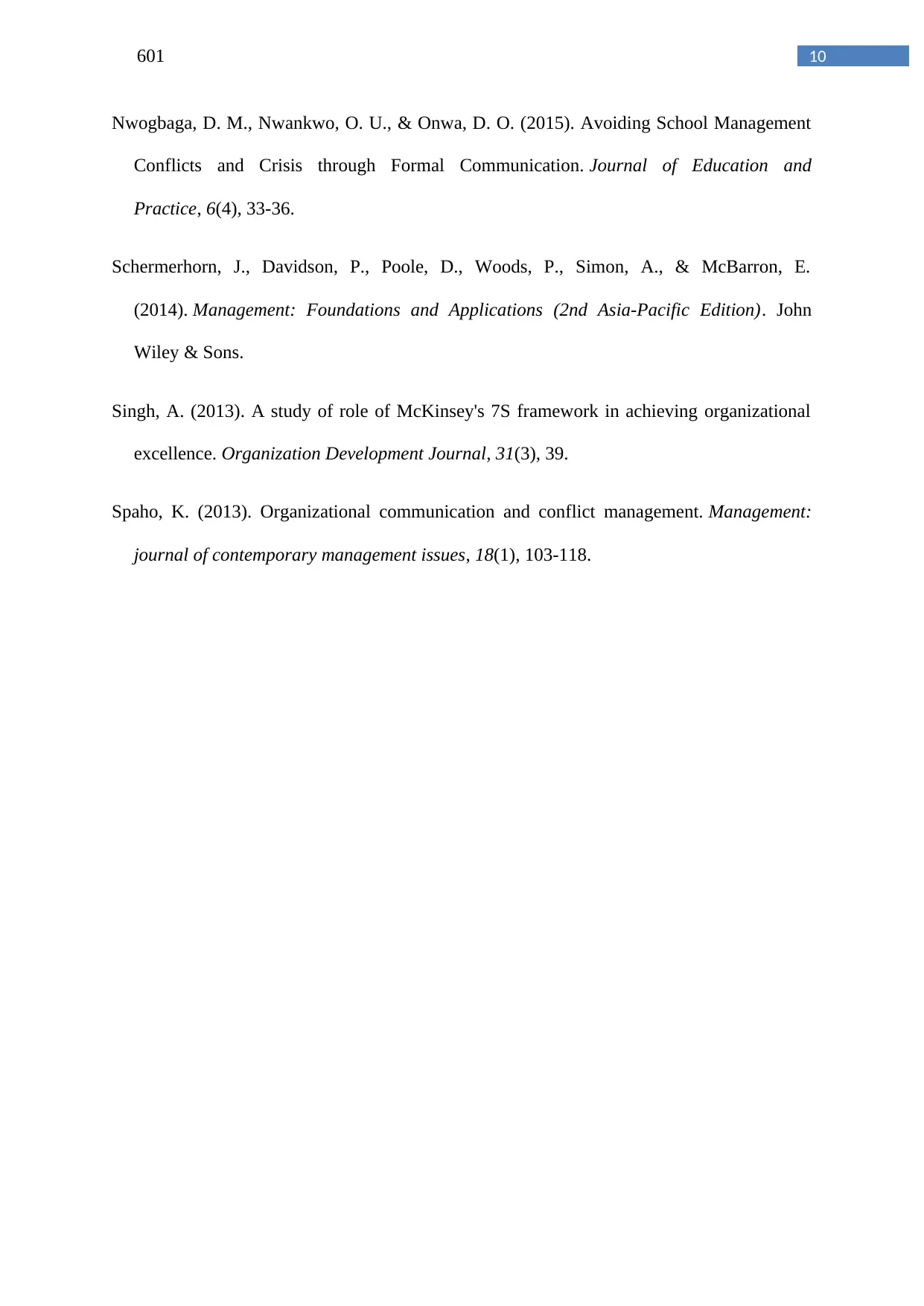
10601
Nwogbaga, D. M., Nwankwo, O. U., & Onwa, D. O. (2015). Avoiding School Management
Conflicts and Crisis through Formal Communication. Journal of Education and
Practice, 6(4), 33-36.
Schermerhorn, J., Davidson, P., Poole, D., Woods, P., Simon, A., & McBarron, E.
(2014). Management: Foundations and Applications (2nd Asia-Pacific Edition). John
Wiley & Sons.
Singh, A. (2013). A study of role of McKinsey's 7S framework in achieving organizational
excellence. Organization Development Journal, 31(3), 39.
Spaho, K. (2013). Organizational communication and conflict management. Management:
journal of contemporary management issues, 18(1), 103-118.
Nwogbaga, D. M., Nwankwo, O. U., & Onwa, D. O. (2015). Avoiding School Management
Conflicts and Crisis through Formal Communication. Journal of Education and
Practice, 6(4), 33-36.
Schermerhorn, J., Davidson, P., Poole, D., Woods, P., Simon, A., & McBarron, E.
(2014). Management: Foundations and Applications (2nd Asia-Pacific Edition). John
Wiley & Sons.
Singh, A. (2013). A study of role of McKinsey's 7S framework in achieving organizational
excellence. Organization Development Journal, 31(3), 39.
Spaho, K. (2013). Organizational communication and conflict management. Management:
journal of contemporary management issues, 18(1), 103-118.
1 out of 11
Related Documents
Your All-in-One AI-Powered Toolkit for Academic Success.
+13062052269
info@desklib.com
Available 24*7 on WhatsApp / Email
![[object Object]](/_next/static/media/star-bottom.7253800d.svg)
Unlock your academic potential
Copyright © 2020–2025 A2Z Services. All Rights Reserved. Developed and managed by ZUCOL.




